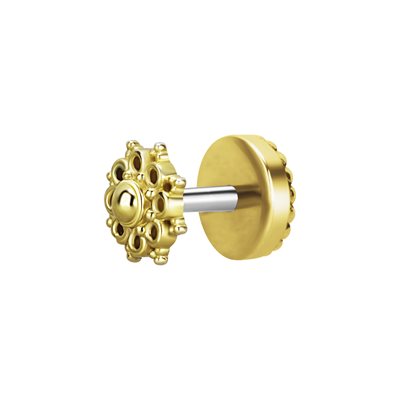- PROFESSIONAL ONLY
- Homepage>
- Body Jewelry and replacement parts>
- Earrings>
- Tribal brass fake plug
Tribal brass fake plug
Product Code: RRMUX03-6-8
-
Contact us for pricing
- Main material : Surgical Steel (316L-ASTM F138)
- Secondary material : Brass
- PVD Coating : None
- Gem type : None
- Threading : External
- Classification : Fake plug
- Quantity Available: 1
Surgical Steel 316
SS316L is a surgical implant grade, which is the most used material for Body Jewelry. The two most common standards that apply to body jewelry made of steel are ASTM F138 and ISO 5832-1 which describe the qualities of steel for surgical implants.
The element in stainless steel that causes allergic reactions in some people is nickel. Polishing the jewelry to a mirror like luster results in a protective layer of chromium oxide, which reduces the release of the Nickel content into the tissue. Surgical Steel can be sterilized in an autoclave.
Check certificate and nickel release certificate for more info. You can also check the latest European directive regarding the use of nickel for body Jewelry.
MAGNETISM IN SURGICAL STEEL 316L
We had some returning questions regarding magnetism in Surgical Steel 316L. Some people still believe that if the steel is magnetic then it is not surgical steel. We would like to emphasize here one more time that this is not true. Stainless Steel 316L is a low-carbon form of 316 steel. Although it is non-magnetic when produced, it may become magnetic when worked.
Brass
Brass is used for its bright gold-like appearance and is popular in piercings for its tribal look. Brass Piercings are used by nature tribes all around the world.
We use a brass alloy of copper, zinc, and silver, which is free of any toxic elements such as nickel, lead, and cadmium.
We do not recommend brass for initial piercings, and they may cause irritation for some people.
BRASS JEWELRY GUIDELINES
First, brass jewelry isn't giving the same allure as if they are gold, silver or rose gold plated. What we look for in a brass jewel it's that special brown vintage look of tribal jewelry.
Yes, it does leave a green stain where jewelry was worn, but that stain is usually a result of a metal in the jewelry reacting with your skin — or something on your skin, such as hand lotion.
When the acids on your sweaty skin (or in your lotion) causes the copper in the jewelry to corrode, the process creates copper salts. These blue-green compounds can leave a mark on your skin in that iconic shade we call "Statue of Liberty Teal."
Other metals can produce similar effects: The silver present in Sterling silver and used as an alloy in a fair amount of gold jewelry, can oxidize when it comes in contact with skin. This causes tarnishing and can leave you with a dark-green or black stain. Although these marks are often associated with cheaper jewelry, they can happen with the pricey stuff, too.
Stainless steel and white gold are usually immune.
The good news is that even the toughest tarnished brass piece, we can simply clean it by leaving it for up to 30 minutes (if very tarnished) in just Ketchup and water. It will all come as new.
Taking your jewelry off before washing with soap will also reduce the chances of going green.


